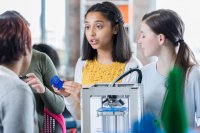The Science Classroom Makerspace
In freshman biology, lab work and design thinking come together through maker education.
Discussions of maker education often dazzle with stories of fanciful robots, exotic materials, and whimsical ideas for cross-disciplinary projects. These impressive examples showcase the amazing things creative people can do, but when I wanted to build making into my freshman biology course, I felt stymied. When I reframed making as integral rather than optional, I found a way to let students create.
Rewriting What’s Already in Your Course
The first major step was not finding a place to add a making opportunity to my curriculum—there was no room for “extra” in my calendar, and I bet there isn’t in yours either. Instead, I looked for places where the class material was related to things students could create in the classroom.
I chose water contamination because the topic wrapped up several major biogeochemical standards for my course: matter cycling, human impacts in ecosystems, and organismal interactions.
I’ve discussed research showing that giving students the freedom to explore a full, rich example yields better sense-making for students than many isolated pieces of work created by an instructor, and I scheduled about two weeks for my students to be making. We had a few class activities about natural water cycling, and then students had a couple days to build a small version of the same natural cycling systems. Next we took a couple days to examine the ways in which humans add nitrogen to the environment, and then students returned to their projects to see how their addition of human-processed soil added nitrogen to their systems. They then spent a few days building new prototypes of their systems, and then we moved back to another class discussion.
Switching back and forth kept students’ interest in the project high, provided time for brainstorming and independent work, and let me make connections to our other class activities while the content was fresh because of their making efforts.
Providing Options, Feedback, and Space
My final worry was about how I could direct the students. If I just said “go” without any guidance, the students would all cluster around the simplest and most obvious materials, so I chose a more opportunistic approach and gave them just a little bit of guidance.
I projected a live stream of the makerspace onto my whiteboard when we started. Now all students in the room could see what was happening in the makerspace moment to moment.
When the project started, I gave a quick tour of the makerspace and pointed out the major areas in which they could work: “Here’s some wood and plastic, there’s some hand tools, the 3D printer is over here, and some power tools we can use if you ask.”
I then let them decide for themselves how to proceed. The start of that first workday was... awkward. But it didn’t stay that way.
A few students wanted to 3D-print something. I shouted out that we were training on how to prep a 3D model, and a handful of other students wanted to join, so we all got a quick starter training on how to find something to print. Most kids ignored us—and that was fine. Later some other students wanted to use the 3D printer, but now I could direct them to the earlier students who were trained on the tool.
This happened in other areas as well. Some students started working with the wood. When their peers saw them on the screen digging around in the woodpile, a few more decided to go check it out with them.
These choices were evaluated on the best day of the project. During prototype testing, right in the middle of the project, students got real, usable feedback on their designs: We poured some contaminated water through their systems and used a nitrate sensor to measure the water contamination. I calibrated and ran the sensor, and it gave them an honest evaluation of their progress.
I was amazed when a design I didn’t like was among the most effective, and I was heartbroken when one group’s creative design actually made the water worse—a great learning moment as they worked out how they had gone wrong.
In every case, the sensor hadn’t even left the test water before the students were comparing results and trying to figure out why each design had performed the way it had. Their discussions were exactly what the NGSS expects of Kansas students. Each group then had the opportunity to continue working on their projects, confident that their choices mattered.
Never forget that the tools and materials in a makerspace are means to an end: students exploring their own creativity. Providing more tools gives the students options, but no single tool is more important than the students’ ownership over their ideas and processes. What matters is that they have room to tinker, to fail (and recover), to innovate, and to surprise.
